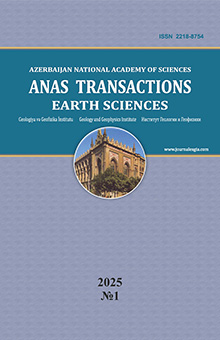№ 1,
2019
Məqaləni yüklə
Cənubi Xəzər hövzəsinin şimal-qərb cinahinda karbohidrogenlərin izotop-geokimyəvi səciyyəsi
AMEA Geologiya və Geofizika İnstitutu AZ1143, Bakı şəh., H.Сavid prosp.,119: fakper@gmail.com
Xülasə
A-
A+
Bu məqalədə Cənubi Xəzər hövzəsində (Qobustan, Qərbi Abşeron rayonları və bitişik sahil zonası) neft və qazın izotop-geokimyəvi xüsusiyyətlərinin müxtəlif aspektləri təhlil edilir. Burada geniış yayılmış neft və qazın təbii təzahürləri tektonik qırılmalar və palçıq vulkanları (PV) ilə əlaqədardır. Bioloji aşınmaya məruz qalmış və kükürdün miqdarı 0,5%-dən az olan PV neftləriı, əsasən, naften-parafin tərkiblidir. Neftin və ana süxurların karbohidrogen ekstraktının nümunələri qaz-xromatoqrafiya, mass-spektrometriya və onların kombinasiyası (biomarker analizi) üsullarının köməyi ilə öyrənilmişdir. Neft-neft və neft-ana süxur korrelyasiyası aparılmış və müəyyən edilmişdir ki, neftlər, əsasən, dərinsu şəraitində yığılmış Miosen yaşlı üzvi materialdan əmələ gəlmişdir. Neftlərin yetkinliyi aşağı və ya orta dərəcəyə (Ro = 0,75-0,85) uyğundur. Neftlərin və süxur ekstraktlarının alifatik və aromatik fraksiyaların karbonunun izotop tərkibləri (KİT) arasındakı asılılıq Məhsuldar qatda (alt Pliosen) olan sənae neft ehtiyatlarının mənbəyinin əsasən Miosen çöküntüləri (Diatom, Çokrak və üst Maykop) olduğunu göstərir. Qazların mənbəyi 3He/4He nisbətinin qiymətlərinə görə çöküntü örtüyüdür. Qazlar da qarışıq dəniz (dominant) və yerüstü üzvi fasiyalardan əmələ gəlmişdir və onlar neftlərin termal krekinqinin məhsulu deyil. Hesablanmış neft mənbəyin dərinliyi 6,1-8,6 km-ə bərabərdir (qaz mənbəyi 8,1-dən 15,8 km-ə qədərdir). Qazlarda CO2 ağır KİT-nin dayaz dərinliklərdə (2 km-dən dərin olmayan) karbohidrogenlərin mikrobial dağılması ilə əlaqədardır.
Açar sözlər: neft, qaz, ana süxurlar, üzvi maddə, geokimya, korrelyasiya, Cənubi Xəzər hövzəsi
ƏDƏBİYYAT
Faber E. About isotopic geochemistry of gaseous hydrocarbons. Erdol, Erdgas, Kohle, V. 103, Iss. 5, 1987, pp. 210-218 (in German).
Feyzullayev A.A. Mud volcanoes in the South Caspian basin: nature and estimated depth of its products. Natural Science, V. 4, № 7, 2012, pp. 445-453.
Feyzullayev A.A. Physicochemical interactions in the sedimentary rock – fluid system in the South Caspian basin in connection with oil-gas ontogenesis. Proceedings of ANAS, The Sciences of Earth, № 4, 2010, pp. 28-45 (in Russian).
Feyzullayev A.A., Aliyeva Es.A. Estimation of the various source rocks contribution in oil pools formation. Proceedings of EAGE 65 Conference and Exhibition. Stavanger. Norway, 2-5 June, 2003.
Feyzullayev A.A., Movsumova U.A. The nature of the isotopically heavy carbon composition of carbon dioxide and bicarbonates in the waters of mud volcanoes in Azerbaijan. Geochemistry International, V. 48, № 5, 2010, pp. 517-522.
Feyzullayev A.A., Tagiyev M.F., Lerche I. On the origin of hydrocarbons in the main Lower Pliocene reservoirs of the South Caspian Basin, Azerbaijan. Energy, Exploration & Exploitation, V. 33, № 1, 2015, pp. 1-14.
Galimov E.M. Carbon isotopes in oil and gas geology. Nedra. Moscow, 1973, 384 p. (in Russian).
Guliyev I.S., Feyzullayev A.A., Huseynov D.A. Geochemical features and source of fluids of mud volcanoes in South Caspian basin in lights of new data at isotopes С, Н, and О. Geochimiya, № 7, 2004, 792-800 (in Russian).
Irwin H., Curtis C., Coleman M. Isotopic evidence for source of diagenetic carbonates formed during burial of organic rich sediments. Nature, V. 269, Iss. 5625, 1977, pp. 209-213.
Kissin I.G., Pakhomov S.N. On the possibility of generation of hydrocarbonic acid in the interiors under moderately high temperatures. Doklаdy AS of the USSR, V. 174, № 2, 1967, pp. 451-454 (in Russian).
Marzi R., Torkelson, B.E., Olson R.K. A revised carbon preference index. Organic Geochemistry, V. 20, № 8, 1993, pp. 1303-1306.
Pallasser R.J. Recognising biodegradation in gas/oil accumulations through the 13C compositions of gas components. Org. Geochem., V. 31, № 12, 2000, pp. 1363-1373.
Peters K.E., Moldowan J.M. The biomarker guide: interpreting molecular fossils in petroleum and ancient sediments. Prentice Hall. Englewood Cliffs, New Jersey, 1993, 363 p.
Valyaev B.M., Grinchenko Yu.I. Source of isotopically “ultra-heavy” carbon dioxide in natural gases. In: Proceedings of 10th All Union symposium on Stable Isotopes in Geochemistry, Moscow, Russia, 1984, p. 170 (in Russian).
Wilhelms A., Larter S.R., Head I. et al. Biodegradation of oil in uplifted basins prevented by deep burial sterilization. Nature, V. 411, 2001, pp. 1034-1037.
Zartman R.E., Wasserburg G.J., Reynolds J.H. Helium, argon and carbon in some natural gases. J. Geophys. Res., V. 66, 1961, pp. 277-286.
DOI:
10.33677/ggianas20190100021
